Alberta’s Demand for Workers is Affecting BC’s Labour Market
By Ken Peacock and Jock Finlayson
Within Canada there are no restrictions on labour mobility.1 People move freely between provinces to find employment, to retire, to attend school, or for other reasons. The past few years have seen mounting anecdotal evidence that strong demand for workers in Alberta is impacting the BC labour market by luring younger, often skilled workers from this province. Some employers in BC report they have been losing employees to our eastern neighbor. Looking ahead, this trend is likely to contribute to a tightening of the BC labour market as economic growth gradually accelerates.
The data tracking interprovincial migration patterns confirm that British Columbians are now re-locating to Alberta in significant numbers. In addition to higher-paying jobs, we can assume that lower housing costs are also playing a role in attracting younger BC families to Alberta.
There is another dimension to Alberta’s impact on BC’s workforce, however. This takes the form of people who continue to reside in British Columbia but work and earn their living in Alberta. This short report examines both elements of the outflow of workers – interprovincial migration and out-of-province employment by residents – to evaluate to what extent is Alberta is serving as a drain on the pool of young, skilled workers in BC.
Inter-provincial Migration Between BC and Alberta
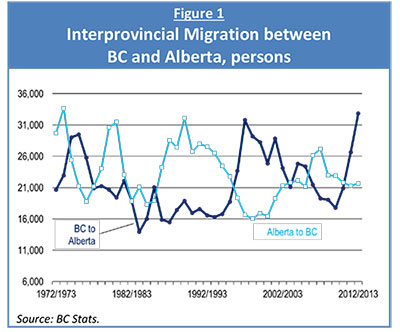
We begin by looking at the flow of people moving between BC and Alberta. Here the most notable development is that a record number of British Columbians relocated to Alberta in 2012-13 (see figure 1). However, after adjusting for population size, it turns out that the outflow was actually greater in the early 1970s and in 1997-98 period.
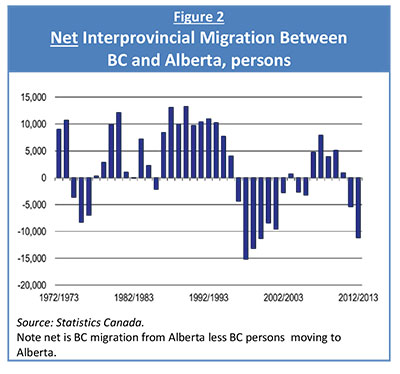
On a net basis – the inflow of people to BC minus the outflow – the loss of BC residents to Alberta was highest in 1997-98 (see figure 2). After a few years of net inflows from Alberta, BC is once again experiencing a sizable net outflow of residents to Alberta.
The net outflow of British Columbians to Alberta has not been unusually large and it remains below the numbers recorded in the late 1990s. However, in the latter part of the 1990s the BC unemployment rate was around 8.8%, more than two percentage points higher than it is today. And there were few if any reports of skill shortages in the late 1990s. For these reasons, we believe interprovincial migration to Alberta today is having a bigger impact on labour supply in BC than it did in the 1990s.
Of interest, if one takes a longer-term view, over the past decade the flow of people between BC and Alberta has been roughly balanced; but looking at the past two decades, BC has experienced a cumulative net loss of approximately 42,000 people.
Not surprisingly, given geographic proximity and relative job opportunities, Alberta dominates BC’s interprovincial migration. Typically Alberta becomes home for about half of all BC residents who move out of the province each year. In 2012/13 Alberta was the destination for 56% of BC’s interprovincial out-migrants. In the reverse direction, BC became the destination for 43% of Alberta out-migrants in the same period.
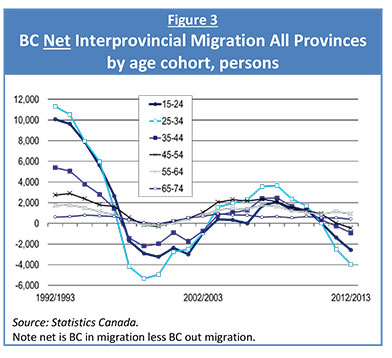
In thinking about how interprovincial migration influences the labour market, the age of migrants is an important consideration. Figure 3 depicts net interprovincial migration by age cohort for British Columbia. Note that the figure measures the total flow of persons between BC and all other provinces, because data on flows to/from Alberta by age cohort is not readily available. Since people moving between Alberta and BC account for about half of all BC’s interprovincial migration, the overall flows are probably a reasonable reflection of the pattern vis-à-vis Alberta.
As might be expected, younger age cohorts drive much of the migration between provinces. In the most recent year, BC recorded a net loss of nearly 4,000 people between the ages of 25 and 34 to other provinces. The next largest outflow was for 15 to 24 year olds, in which BC had a net loss of 2,600. The province also posted a net outflow of nearly 1,000 35-44 year olds. Adding these groups together, the data indicate that BC lost 7,500 core working age people last year (we estimate that slightly more than half of these went to Alberta). Note, however, that the net outflow of core working age British Columbians was greater in the latter part of the 1990s.
Interprovincial Employees
The other dimension of interprovincial labour flows is people who work in another province but officially retain their residence in their home province. Here, we are particularly interested in how many BC residents are working in next-door Alberta.
Quantifying the number of interprovincial employees is difficult. But using administrative tax data, Statistics Canada recently completed a study that sought to count the number of these workers.2 The study finds a large number of interprovincial employees working in Alberta. In 2009 – the latest year for which data are available – 97,000 interprovincial employees resident in other provinces were employed in Alberta; this was up significantly from the 62,000 five years earlier. Residents of Saskatchewan and BC accounted for the largest shares of interprovincial workers holding jobs in Alberta.
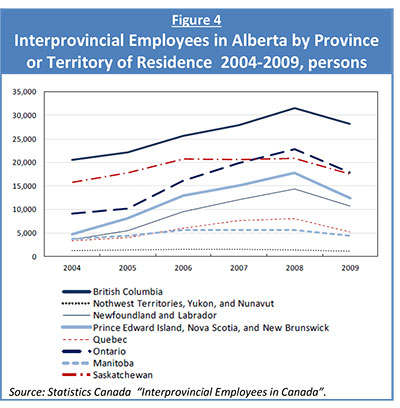
As is evident in Figure 4, roughly 29,000 British Columbia residents were working in Alberta as of 2009. In the same year, Saskatchewan and Ontario each had some 18,000 of their residents employed in Alberta. Our judgment is that for British Columbia, the numbers have increased since 2009.
In 2009, the ratio of the number of people from BC working in Alberta relative to total BC employment was 1.2%. Although BC had the largest absolute number of inter-provincial employees working in Alberta in that year, proportionally the share of workers with jobs in Alberta was higher for Newfoundland and Labrador (4%) and Saskatchewan (3.2%).
As with interprovincial migration, the age profile of interprovincial employees is tilted towards younger age cohorts. Of all inter-provincial employees in Alberta in 2009, 27% were between the ages of 18 and 24. Another 25% were in the 25-34 age group. The 35-44 and 45-54 age cohorts each accounted for 17% of interprovincial workers in Alberta in 2009. And those aged 55 to 64 made up 10% of all interprovincial cross-border workers holding jobs in Alberta.
It is worth noting that just 45% of British Columbians who are interprovincial workers report T4 earnings only from Alberta, while 55% have earnings in Alberta and another province. It is tempting to conclude that under half of all BC-resident interprovincial employees are engaged in full-time work in Alberta (i.e., commuting to Alberta and working for 10 or more days then having five or more days off). But these kinds of employees could also be working for a limited number of hours in BC when they are at home and thus reporting small amounts of BC-derived employment income.
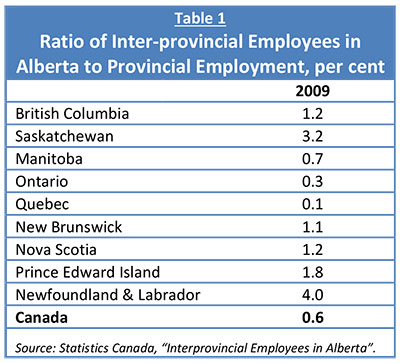
Examining both interprovincial migration flows and interprovincial employees suggests that Alberta is having a significant effect on BC’s labour market – particularly on the supply of workers. We believe this is exacerbating hiring challenges in certain sectors of the BC economy – and that the challenges are likely to intensify in the coming years as BC’s economy picks up and the pace of major project activity accelerates with the development of a sizable LNG industry in the province.
Both the migration data and the interprovincial employment numbers indicate that younger age cohorts are most likely to relocate or commute interprovincially for work. Many British Columbia employers hoping to attract and retain educated and skilled younger workers will continue to face pressure from the powerful draw being exerted by strong labour demand and comparatively high pay levels in Alberta.
1 Canadians are free to move between provinces. To gain employment in some regulated occupations and professions, however, it may be necessary to get licensed if one re-locates to a different province.
2 Christine Laporte, Yuqian Lu and Grant Schellenberg, “Interprovincial Employees in Alberta,” Statistics Canada Research Paper (September 2013).
Ken Peacock is the chief economist and vice president at the Business Council of British Columbia.
Jock Finlayson is the executive vice president and chief policy officer at the Business Council of British Columbia.
This article was originally published by the Business Council of British Columbia, April 2014.








